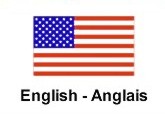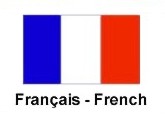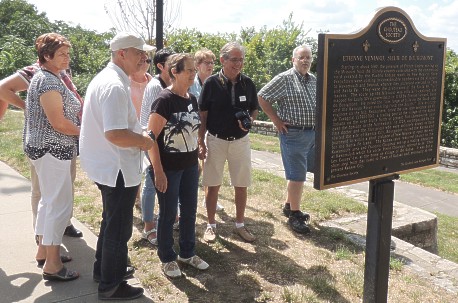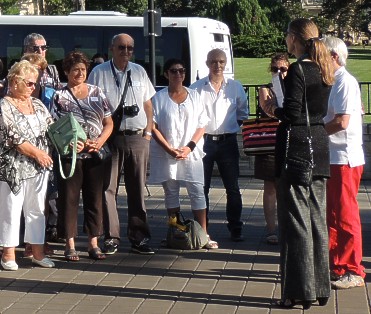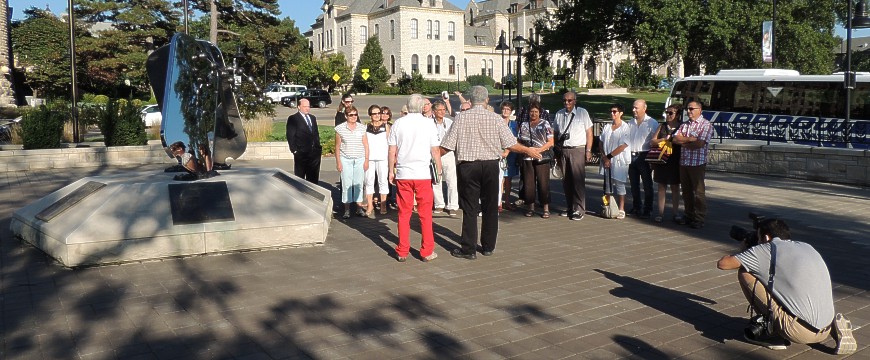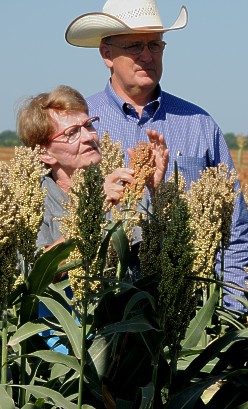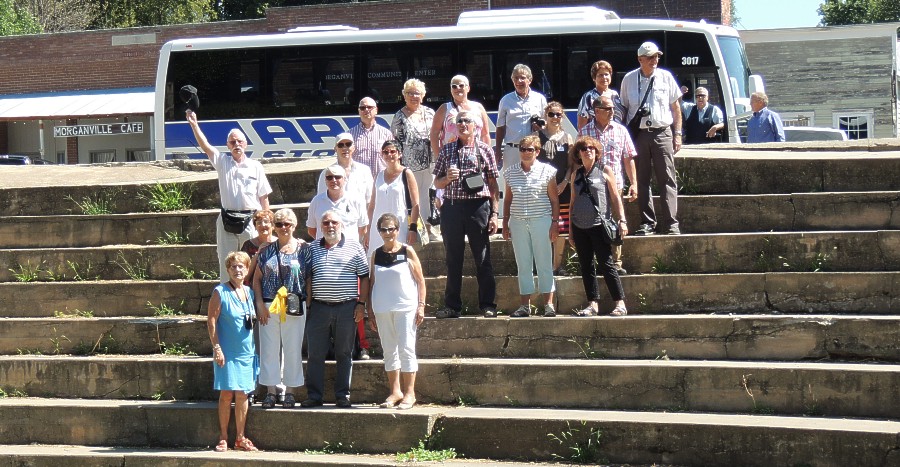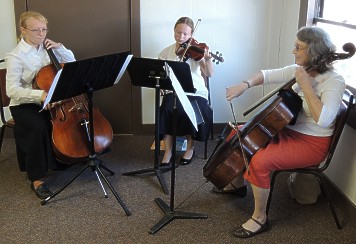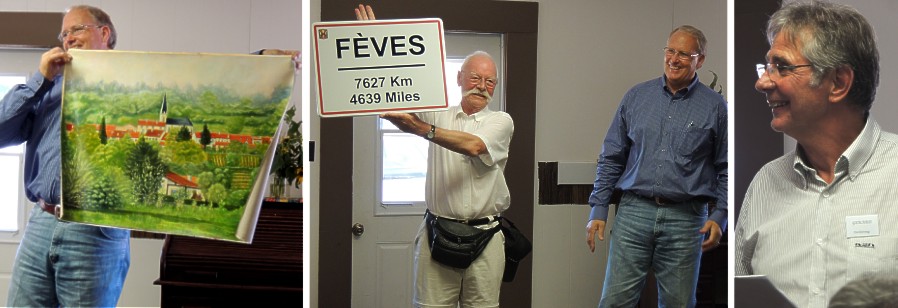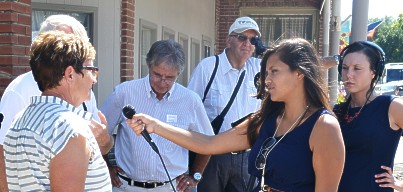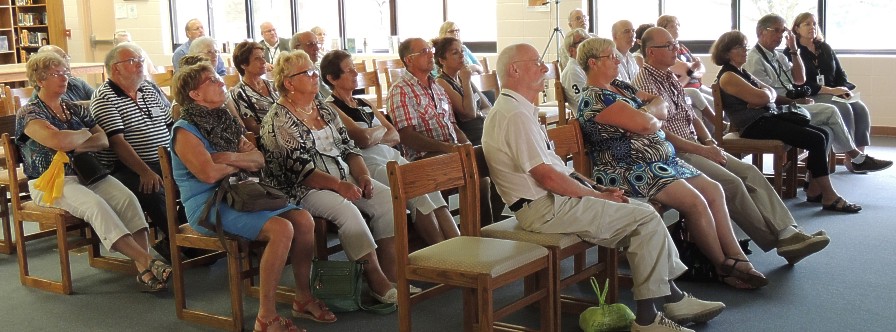Arrival in Kansas City
At 10 a.m. on September 9, when the Fèvotes arrived at the Kansas City airport, Freeland and Vaughan were waiting to greet them. After collecting the luggage, the group traveled by the chartered bus to the nearby Cracker Barrel restaurant for an early lunch. Pracht was initially kept busy translating the various menu items. The visitors were a bit confused by the seemingly endless selection of unfamiliar salad dressing options until Pracht mentioned that one selection was "French." It immediately became the unanimous choice.
The first stop for the visitors was the Cracker Barrel restaurant. Pracht is at the top-rear, translating for the waiter.
The group had made one request for their visit to Kansas City: a tour of the Harley Davidson factory on the city's north side. No one
in the group owned an HD motorcycle, but most thought it would be fun to visit a plant where the iconic American product was
manufactured.
When the tour was complete, everyone climbed aboard the bus to travel to the National WWI Museum and Memorial in the heart of
Kansas City. Vaughan spent the early portion of the trip describing the founding of the city and the important role the Choteau
family and other French explorers and traders had played in its development.
An impromptu diversion was implemented when the bus driver suggested a stop at Case Park on the banks of the
Missouri River, the location of the memorial celebrating the Lewis and Clark expedition of 1805. All were surprised
and pleased to discover that the marker was in French as well as English.
The unplanned stop made the group about an hour late arriving at the World War I museum, but with the help of French-language
headsets that effortlessly guided the visitors, everyone was back on the bus shortly after 5 p.m. to depart for
Manhattan.
Case Park and the Lewis and Clark memorial
After checking into the Hampton Inn on Manhattan's east side, the group traveled to Cox Bros. BBQ for supper. The differences in the meanings of the word barbeque arose again. The Fèvotes were confused why there was a carousel of sauces at the center of each table. Vaughan explained, but after a long day, most were not in the mood to be adventurous and so opted for their meat plain.
Morganville
Like the day before, September 10 dawned as a beautiful clear day with blue skies. Despite Vaughan's initial worries, the
temperatures would only reach the low 80s F.
One of the visitors joked with Vaughan that he had heard about the severe weather that plagued Kansas and he was
a bit disappointed to be deprived of experiencing it. No one knew that before the day was over, Kansas would leave them with an
experience to remember!
The group left the hotel for Manhattan's Bluemont Scenic Overlook a few minutes before 9 a.m. Upon arrival, Vaughan had
them gather at its western edge. While pointing out various landmarks, he explained how the area had been settled and
the important role the university had played, and continues to play, in the community.
Meanwhile, Freeland was at the university, arranging for their arrival.
Atop Manhattan's Bluemont Scenic Overlook
Upon arriving at the campus, the bus stopped at the World War II Memorial. University Provost April Mason was the first to
speak, extending a welcome from the university. Birgit Wassmuth, head of the journalism department, greeted the visitors in
French.
Vaughan then explained that particular meeting location had been chosen for three reasons. One was its obvious
connection to World War II. He drew their attention to the nearby chapel built in honor of those from the university
who had died during that war, emphasizing that among them were men who had fought and died in Lorraine.
Provost Mason, in black, welcomes the visitors.
Drawing attention to the large replica of "dog tags" at the center of the memorial, he explained they were worn by every
American soldier during combat. In the event of the soldier's death, one tag remained with the body to act as
identification, while the other was retrieved by army personnel to initiate the process of recording his passing. Vaughan
added that the model for the sculpture were the actual tags worn by John Lindholm, a B-17 pilot in Europe during the war and
Vaughan's boss many years later when both were teaching at the university.
The second reason the location was chosen was because Kedzie Hall, the building where both Freeland and Velma Carson had
spent so much of their time, was visible just to the west. Vaughan explained Carson's critical role when a show of hands
revealed none of the visitors were aware of her part in connecting the two villages.
The third reason for selecting the location was because Anderson Hall, the university's main administration building,
could be seen to the northwest. Milton Eisenhower, the brother of WW II European commander General Dwight Eisenhower, had worked
there as university president. His efforts on behalf of UNESCO had provided critical momentum to the Morganville-Fèves project
in late 1947 and early 1948.
Vaughan speaks to the visitors with Pracht, to his left, translating. The memorial at the left is for World War II soldiers and features a replica of a set of "dog tags." Behind the group is Anderson Hall. At the lower right, a photographer frames a photo for the university newspaper. Kedzie Hall is obscured by the trees at the left.
When Vaughan finished, student Rafael Garcia, a reporter with The Collegian, the Kansas State University newspaper, interviewed
members of the group about their trip to Kansas.
A short bus tour of the campus followed before the group left Manhattan for Clay County.
In Clay Center, they stopped to pick up Brent Rundell, who would serve as their guide for the next portion of the day. Much
of the business of Kansas is agriculture and that certainly was, and is, true of Morganville. While Rundell was
Morganville’s mayor, his profession was as an agribusiness manager for Wilbur Ellis, an international supplier of
agricultural technology and products. Rundell’s job was to develop fertilizer, herbicide, and seed programs for
individual growers based on observations he made while inspecting their fields.
West of Clay Center on Highway 24, the bus turned north on Hackberry Road. After two miles, Rundell asked the driver to stop.
Rundell then gathered the visitors on the west shoulder at the edge of a milo field. Drawing attention to the striping of the
field, he reminded them of the photo presented to the people of Fèves during Vaughan and Freeland's 2014 visit.
Some walked into the field with Rundell to inspect the plant heads while he explained what he looked for in assessing
the health of the crop.
Once back on the bus, the group headed north until they reached 23rd Street. Vaughan pointed to the northwest, where the
Carson homestead had once stood.
They crossed the Republican River and then entered Morganville before turning north on Mill Road. In 1948, the road
did not exist as it was the roadbed for the trains that had transported Morganville's gifts away from the village to
begin their journey to France.
Visitor Francine Hanen inspects a milo head with Rundell at her side.
The visitors again left the bus at Taddiken’s Land and Cattle Company. Owner Scott Taddiken introduced them to the large tractors and combines used on area farms. When finished, many accepted the invitation to take a ride around the lot in one of the large machines.
Several visitors took a short journey about the Taddiken grounds in this combine, while others looked on.
After a short bus ride, Bob Clark welcomed the group to the Morganville grain elevator and explained the importance of farmers
having a place to store their crops after harvest. Then everyone moved outside to the truck scale, where Clark measured
their combined weight.
The Fèvotes again boarded the bus to travel to the Morganville café.
Upon arrival, everyone was immediately drawn to the Stadium across the street, where the play had been performed a bit more than
67 years earlier.
With fellow Fèvotes on the Stadium steps, Roger Wechtler raises his cap to the photographer. The sign for the Morganville Café can be seen behind the bus.
As each person's curiosity was satisfied, one by one they crossed the street and entered the café.
Just inside, youngsters Dana Dean on the cello, Dahlia Dean on the violin and their tutor Anne Clark, also on the
cello, were playing "En passant par la Lorraine," - Going through Lorraine. It is a piece most of the visitors would have
learned as school children and many sang along.
When the trio began "La Marseillaise," the French national anthem, all joined in.
Dana and Dahlia Dean and their tutor Anne Clark
The group had been scheduled to arrive at the high school in Clay Center about 45 minutes later, so little time was wasted starting the meal. But as a precaution, the school was informed there was a high likelihood the group would arrive late.
KSU journalism students Meagan Miller and Daniela Martinez-Serrano had set up their cameras inside the café and had been
recording since the visitors' arrival. The pair were producing a short news item about the connection between the sister
cities.
Gary Oetinger, one of the actors in the 1948 play, said a blessing and then everyone settled down to their second meal
of Kansas barbeque.
Gary Oetinger, left, and Jay Mellies, were both in the 1948 play.
A short informal ceremony followed the meal. Freeland and Charlotte Rundell were presented with gifts of enamelware from Longwy,
France. Torlotting gave a short speech, again spoken phonetically, which began, "Since my last visit, I have not learned English."
He, with the help of Pracht's translation, presented Mayor Brent Rundell with an oil painting of Fèves painted by one of its
citizens. Roger Wechtler presented the mayor with a road sign that proclaimed Fèves was 4,639 miles away. Rundell
vowed to have it displayed at the edge of the village.
Left: Morganville mayor Brent Rundell holds an oil painting of Fèves created by one of its citizens; middle: Roger Wechtler presents Rundell with a road sign with the distance from Morganville to her sister village; right: Torlotting speaking
When the ceremonies were concluded, the group filtered back onto the main street. Miller and Martinez-Serrano corralled several of them for interviews.
It was almost 2:30 p.m. when the group boarded the bus for Clay Center - more than an hour after the time they had been scheduled to arrive at the high school.
Daniela Martinez-Serrano, left, and Meagan Miller interview Solange Torlotting, while husband Gérard and Marc Davoli wait their turn. All three were 1949 aid recipients.
Still, there was one more stop they had to make before leaving Morganville. Always thinking ahead, Torlotting wanted an eye-catching photo the newspaper back home would want to publish.
So everyone boarded the bus for the short trip to the eastern edge of the village. There the Fèvotes crowded about
the village marker board for a group photo.
With everyone enjoying themselves so much and the knowledge that few, if any, might return in the future, there was
little appetite to encourage the visitors to move more quickly. The group finally arrived at the high school in Clay Center
after the 15-minute journey from Morganville. A reception committee was waiting curbside. Students, serving as guides, had
practiced a few words of French to facilitate the school tour. Important points included the location of the toilets.
A photo for the newspaper in France
A few minutes after 3:30, the visitors, people from the school district and others connected with the story, such as Haney and pageant participant Lois (Pierson) Eggerman, gathered in the school library. A welcome by school board member Jean Frigon was followed by a partial reading of Carson's script by three students in teacher Megan Blackburn's drama class. Vaughan then played an expanded version of the video presented at the December 2013 reception. Captioned in French, he gave several copies to Torlotting to take home as gifts.
The visitors, school personnel and others connected with the pageant watch a video of the Morganville-Fèves story after completing a tour of the high school and listening to a portion of Carson's play delivered by three drama students.
Around 5 p.m., the group boarded the bus to return to Manhattan. While the trip back involved much animated discussion about the events of the day, attention was frequently drawn to the western skies, where ominous black clouds boiled and bolts of lightning were occasionally seen.
The Storm
The plan for the evening had been to return to the hotel and then meet at 7:30 p.m. for supper at the Coco Bolo restaurant
at the southeastern edge of the university campus. After, people could either wander the university grounds or the
nearby Aggieville business area before returning to the hotel at 9:30 p.m.
Yet as the designated 7:15 p.m. hotel departure time neared, the televisions were filled with news of rapidly-approaching bad
weather. But after some considerable deliberation, it was decided to venture out because the storm track appeared to be passing
to the north of the city.
The bus had barely left the shelter of the hotel reception area when a gentle rain began to fall. Just a couple of
minutes later, the wipers on the bus had difficulty keeping the driver's window clear. Lightning strikes were frequent
and loud. Strong winds whipped bushes, trees and wires.
By the time the bus turned west on Bluemont Avenue, the heavy rain had filled the street with water to curb level and
continued steadily as the bus approached the restaurant.
An exceptionally loud and bright lightning strike surprised the then-quiet riders. Immediately, all of the lights
in the buildings along the south side of the road went dark - including those at the restaurant.
Vaughan suggested they pull into the nearby university parking lot and see if the weather would pass. This was barely
completed when Freeland received a call from daughters Katherine and Mariya, who had been waiting inside the restaurant. They
had been informed by restaurant personnel that water was rapidly flowing into the kitchen area and so there would be no
food served that night, even if the power was restored soon.
After some discussion and a phone call to determine if they were open, a vote was taken and passed that the group should
make its way to the La Fiesta Mexican restaurant in the Blue Hills Shopping Center.
But even that trip was not without incident. The water had collected to such a degree on North Manhattan Avenue that there
was concern over whether it would be high enough to bother the bus's engine. As nervous passengers peered from the windows,
the bus crept slowly forward. Vaughan and Freeland learned that night that the well-known French expression "Ooh là là"
was not limited to the burlesque halls of Paris, but was used in any situation of developing surprise. But despite some angst,
the group arrived at the restaurant safely.
KSU's Ron Wilson joined them at the restaurant, as he wanted to do a story about the visit for his radio show and column
"Kansas Profile."

Left: Although still afternoon, storm clouds materially dimmed the sunlight; middle:
the "Ooh là là" ride to the Mexican restaurant; right: the day ends well as supper is served.
Everyone was pleased with the food, and by the time they boarded the bus for the hotel, the worst of the weather had
passed. The visitors left for the Kansas City airport the next morning with their curiosity about Kansas' unpredictable weather
fully satisfied!
